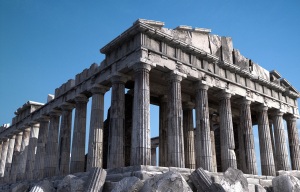The following story is a guest post by Benjamin Dancer. Benjamin Dancer wrote the novels Patriarch Run, In Sight of the Sun, and Fidelity. The Parthenon is an excerpt from his new novel A Tale of Shame and Grace, a story about a mother and her teenage daughter. You can learn more at BenjaminDancer.com.
Teri was nursing her baby when her elder self knocked on the door to the attic room.
“Can I come in?” she asked.
“Please.” Teri had been trying to remember something important and the old woman’s attendance was welcome. It was a question posed by her teenage self. “I can’t remember what she said.”
The woman reminded her. “What does she need?”
“Right.” Teri gestured for her to sit beside her on the floor. Her daughter would be graduating high school in the spring, which meant Teri felt late in the question’s pursuit. “A mother,” she remembered the answer now, too. “She needs a mother.”
She had uncovered that truth in the past. But what did it mean? She couldn’t put it to words yet, not precisely; however, she knew it had something to do with herself. That she was in her daughter’s way, and to understand what that meant, she needed to go back in time and ask the teenage version of herself.
The old woman chose to sit on the floor opposite to Teri. “She also needs to destroy her mother.”
“Why?” It hurt to hear her say that. “Why does she want to destroy me?”
The baby was caressing Teri’s naked breast with her tiny hand.
The old woman answered, “Because the teenager is caught between the infant and the woman.”
Teri considered that. The infant was unable to distinguish between herself and her mother. In fact, to the young child the pair were the same being.
“We were propelled,” her elder continued, “by an inexorable force to separate, to become our own woman. That compulsion was as frightening to us as it was to our mother. We were not aware of our fear. It confused us. We knew only the anger.”
“It hurts,” Teri confessed.
“It hurt us then, too.”
“What do I do?”
“Embrace her.”
“How do I embrace anger?”
“The destruction we wrought was necessary. How else could we have constructed a self?”
“She won’t let me in. It feels like she hates me.”
“Just as she hates herself.”
“What does she need?”
“She needs you to let go of your shame so that you can love her.”
“What shame?”
“The shame that keeps you from her.”
“I don’t understand.”
“Look beneath the pain. There is no safety in shame.”
Teri wanted so desperately to know what the old woman meant. There was nothing she wouldn’t do. But the woman’s words seemed obscure.
“You have to stop looking at your own pain. It is the adolescent’s role to see herself as the victim. It is the mother’s role to provide comfort.”
There was a knock at the door.
“To provide comfort you have to be secure.” The old woman stood. “Accept her. Reach out to her from a point of safety and beckon her in.”
The door opened and the attic room was reshaped into the inner chamber of the Parthenon. The frieze of the entablature around the cella narrated the life of a young girl nurtured by a loving mother. She saw her teenage self, a giant as tall as the fluted columns, wielding a great hammer. She was smashing the sculpture. Dust filled the chamber and debris from the crushed marble ricocheted from the white columns and splashed in the reflecting pool. The lintels, themselves, began to crack, threatening a collapse of the roof.
Teri, wearing a gold tunic and helmet, stood at the front of the chamber. Her teenage self stepped into the reflecting pool and raised the hammer against her. Teri was too terrified to lift her shield. She shut her eyes. The teenage girl swung the great hammer and the milled face struck Teri’s left shoulder, shattering the ivory skin. She struck Teri again and the wooden armature split, and with the third strike, her arm broke off.
“She’s an iconoclast,” the old woman reminded Teri. “It’s her job.”
Teri was near despair. “It just hurts so much.”
“Try to see it from her point of view.”
Teri opened her eyes and saw that the marble columns formed a prison, that the entablature her teenage self sought to remake with her hammer told a narrative that did not account for the girl’s own agency. The teenager was no taller than the plinth on which Teri stood and had built a scaffold to reach the frieze. She looked small and vulnerable amidst the formidable architecture of the temple. The girl was hammering against a relief of her mother, but the tool in her hand was rough and not adequate to relate the exquisiteness of her story.
Teri saw the girl’s bravery for what it was. She seemed heroic in her defiance. Teri wanted to give her the tools she needed, but realized that the girl had to make them herself. That hurt. It hurt to see the girl in so much pain. She remembered now how it felt. The violence of her own individuation was terrifying. She had never existed apart from her mother, and in her attempt to do so, it felt as if she was destroying herself. The anger made her feel like a monster, and she was disgusted with her own enmity. There was so much shame.
Teri was weeping when she looked at the old woman. “What can I do for her?”
“Beckon her to safety.”

Leave a Reply